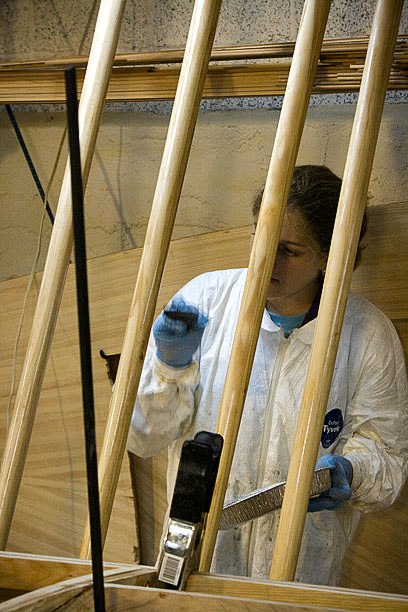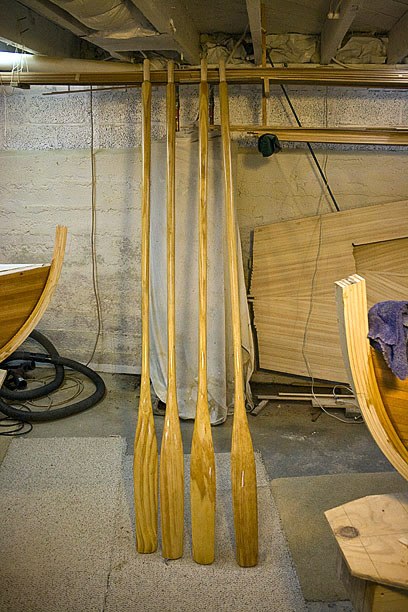“Le Tonk”
Imagine a salesman comes into your shop.
Says he’s got this great new product for your boat. This is how it works:
-Get everything super clean and dust free.
-Wipe everything down with lacquer thinner, so there’s not even a fingerprint anywhere.
-The room can’t be too hot or too cold, and not humid.
-Warm the can, and thin it for the first coat with lacquer thinner.
-Wear a special mask, because the fumes are toxic.
-Put on a very thin coat with a special expensive brush or it will leave streaks and run.
-Wait just the right amount of time for it to dry, but not too long.
-Carefully sand everything smooth, and carefully clean everything.
-Repeat every step.
-Six times.
-When you’re done, wait a week, then wet sand and clean.
“Now, it’s only going to look good for a couple of months, because after you’ve had it out in the sun and weather, heat and cold, it will crack and let moisture in, and you’ll have to sand everything down and do it all over again. Isn’t this great?”
I don’t know about you, but I’d chase that guy away with the biggest stick I could find.
I’m convinced the only reason we still put varnish on boats is because that’s what they did when they didn’t have anything better. So it’s “traditional” to varnish a boat. And truly, varnish is beautiful, and is perfect for violins; but in my opinion it’s a terrible thing to put on a boat. At least for someone like me who hates maintenance.
I also don’t care for any of the modern poly-plastic or chemically stuff, though I’ve tried it. Epoxy needs a protective coating on the surface, though, or the sun will break it down in no time. So I had to do some hunting for alternatives.
Back when I was really poor and just out of college, I didn’t have any table at all and bought an old one literally all in pieces at a junk store. I fixed it up, put it back together, and it turned out pretty good. An old banjo player buddy told me I should put Tung Oil on it, as that was how you got a “hand rubbed” finish the old way. The stuff was so benign you could rub it in with your hand. Sounded good to me, so I tried it and liked it.
That was 30 years ago. That table has been sitting in the sun in a south facing window for all these years, we still eat on it every day, and it still looks great with that original finish, just a little worn on the edges from all the elbow action. This is one of those things that makes you say “hmmmm . . . ”
After quite a bit of digging, I learned of a Tung Oil based finish that was intended specifically for boats, was the official varnish of the French Navy for the last 100 years, in fact. It’s called Le Tonkinois, or “Le Tonk” for short. I decided to take a chance on it.
As far as I can tell, American Rope & Tar is the only distributor in the US for Le Tonk, which concerns me a bit. They’re great people, and I love ordering from them, but I sure hope they don’t go out of business in my lifetime. Very helpful folks, too. I wrote them with questions about using it over epoxy, and they said do a light sanding to put a tooth in the epoxy and it should do fine.
Even a traditional, old school, hand-written receipt. Gotta love it.
As far as application goes, I couldn’t ask for anything better. It’s self-leveling, so no worries about leaving brush strokes. Builds quickly since there’s nothing in it to evaporate, so fewer coats are needed. Non-toxic, no fumes, so skip the masks, gloves and bunny suit (though it does have a very rich aroma). No sanding required between coats, or feathering out touch ups. It doesn’t get brittle and crack, like varnish, but gives with the natural movement of wood as it heats and cools. This little give means it doesn’t get as slippery, so no need for additives the make a non-skid finish for decks. For maintenance over time, just do a light scuff to clean the surface and wipe with water – no solvents, and no more sanding back to the bare wood. Very cool.
I’m a bit concerned that I can’t find any good examples of people who have used it this way, over epoxy. I’ve dug up some minor references on the Wooden Boat forums, and they’ve all been positive, but nothing substantial enough to instill a lot of confidence. My thought at this point is even if it isn’t quite as good as varnish, since it’s so much easier to use I’ll be more likely to keep up with it and add extra coats later, so for me it will be a net gain.
To do a test run, I used the time while the knees cure to finish the oars. (I’m not wasting ANY time if I can avoid it.) Emily offered to help, and Amanda provided the entertainment, so I have reinforcements now, too. We had already put a coat of epoxy on the oars for this test. Today we sanded and wiped them down, then we put on the first coat. It definitely went on easy.
So far, so good. Good enough that tomorrow we’ll use it on the interior of South.
melonseed skiff, mellonseed skiff, melon seed, mellon seed











Dear Barry, I have been bitten by the melonseed bug since I first saw your “basement boats”. The shape of this craft is beautiful!. I have built strip canoes, and was wondering if I could do a small sailboat with this technique, until voila!, I found your youtube. Building 2 at once is something I would love, but I lack the space to store them. I bought the Barto plans, but there is a lot of difference when you are using cedar strips. I was wondering if there was any reference material I could look at before I get my feet wet. I was thinking I might try a 1/2 scale model to see if my skills are up to the task. Great to be able to contact you, I hope I’m not a pain in the rear.
Steve Nickles
Tuesday, January 11, 2011 – 03:51 PM
This weblog was brought to my attention by a friend after I had been having terrible trouble with International “Goldspar” marine varnish not setting hard enough. I probably can’t obtain “Le Tonk” here in Australia, and importing it myself seems equally unlikely, but it is interesting to know of its existence. Love your boat-building work by the way – it’s the sort of standard to which I aspire but will probably never match.
Saturday, February 12, 2011 – 10:06 PM
Alex, Le Tonkinois was “discovered” by the French in Vietnam, they didn’t invent it. So you may have it nearby. My impression is Australia has a fair amount of trade with Southeast Asia. If that’s true, I bet you’ll be able to find it there, or the same thing by a different name.
Part of it’s appeal, though, is that it does not set hard, but is made to stay a little soft (different, perhaps, from something meant to harden that doesn’t.)
Sunday, February 13, 2011 – 01:49 AM
Update, I see two more suppliers for Te Tonk, solventfreepaint.com and sagerestoration.com –2020
Honestly, I have been using Le Tonk for years, but I cannot get the results that are claimed… I keep using it as indeed it DOES go on easy, it does self level, and it does not demand special treatment such as thinning before application.
But, even stripping down to bare wood, sanding smooth, and then wiping down the surface with alcohol to clean… and applying Le Tonkinois, Bio-Impression Sealer before the actual varnish… I have still been unable to achieve a long lasting finish. I feel somehow I have missed a step over the years. Something.
Right now I have teak all over the topside of my Pacific Seacraft Orion that has peeled and cracked Le Tonk all over.
I will once again go through the process of using a heat gun, and scrapers to remove the old varnish, and once again apply Le Tonk, if for no other reason that it does NOT stink, and it does self level, and it does feel good underfoot. But if it lasts an entire winter in the PNW… I will be shocked.
My guess is the difference may well be that your boat stays out in the weather all year? Not likely anything can truly hold up on wood under those conditions, so the benefits are likely relative. Ease of use, and perhaps easier to repair. Mine remain under cover when not in use, which makes a huge difference. The boats are ten years old and each have only had one additional coats added since they were built.